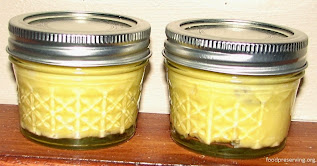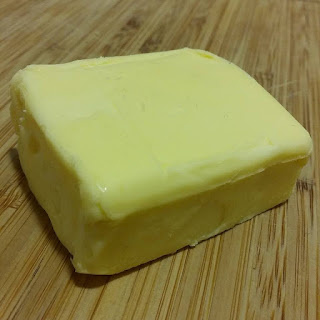Making
your own butter takes only minutes with a butter churn (or bowl mixer). Experiment
by mixing in your favourite spices and flavourings into
your butter - the buttermilk can be used in scones and baking.
Butter and buttermilk are not safe for canning, so keep them
refrigerated or freeze for long-term storage.
|
Ingredients
for BUTTER
|
|
|
Yield: around 240g (8oz) butter plus 1 cup buttermilk
|
|
|
Fresh Pure Cream
(Whipping/Heavy)*
|
600ml
|
|
Salt, Finely
Ground
|
1/4 teaspoon
|
|
Iced Water
|
2-3 cups
|
|
Spices/Flavourings
(Optional)
|
See notes
|
|
*double cream can also be used, however pure
cream, as fresh as possible, will result in a higher yield of butter. Any
brand can be used. Check for a high butterfat content, 35-40% is recommended
for this recipe.
|
|
1.
Remove cream from refrigerator 1 1/2 – 2 hours prior to making butter
(room temperature cream churns into butter quicker than chilled cream).
2.
Wash equipment in warm soapy water, rinse and dry well.
Butter churn:
pour cream into butter churn, add lid and turn handle for several
minutes, until it is very hard to turn and then loosens quickly – you will see
yellow butter and white buttermilk.
Bowl
mixer : pour cream into your bowl mixer. Beat
on medium until thickened slightly then increase speed to high.
: pour cream into your bowl mixer. Beat
on medium until thickened slightly then increase speed to high.
 : pour cream into your bowl mixer. Beat
on medium until thickened slightly then increase speed to high.
: pour cream into your bowl mixer. Beat
on medium until thickened slightly then increase speed to high. TIP: use a
splatter guard when making butter. Continue beating the cream until the butterfat
separates from the liquid. This yellow fat will cling together and
form butter, the watery white liquid is buttermilk.
4. Pour
the buttermilk into a jar and refrigerate or freeze. Buttermilk can be
used for general baking and also in breads and doughs. Culturing the buttermilk
with freeze dried starter (or milk kefir grains) will
thicken and acidify the
butterm ilk, similar to store bought buttermilk – our
favourite for making pikelets! 5. Pour
1 cup chilled water into a bowl, add freshly made butter and mix butter with a spoon,
spatula (or clean hands) to remove excess water for a few seconds. The
semi-transparent liquid can be discarded (or used in bread-making). Repeat 1-2
times until the water is clear.
6. Butter can be left unseasoned, or add salt,
jam, fruit, spices or a combination - see the list below for ideas. Lightly
sprinkle salt (or other flavourings) onto the butter then combine through the
butter by using butter paddles, a spoon, a spatula, or clean hands.
 7. Shape butter with butter paddles, then wrap
in non-stick kitchen paper and refrigerate to consume within two
7. Shape butter with butter paddles, then wrap
in non-stick kitchen paper and refrigerate to consume within two weeks. Alternatively, place butter into freezer-safe containers and label then store in the refrigerator or freezer.
o
raw cultured butter - using cultured
cream (by adding milk kefir grains and straining after 12 hours or to your
flavour liking, then beating the cultured cream to make cultured butter and
cultured buttermilk);
o continental/unsalted butter (no salt,
follow recipe above);
o spreadable butter (225g / 1/2lb butter
+ 1/4 cup oil i.e. extra virgin olive oil, grapeseed or macadamia oil);
o garlic butter (add 2 garlic cloves,
salt, pepper and finely chopped fresh parsley) - great on steak or make garlic
bread/toast;
o garlic & onion butter;
o tomato & onion butter (add finely
diced sun-dried tomatoes or tomato flakes);
o cinnamon butter;
o honey butter;
o cinnamon & honey butter;
o onion, garlic & basil butter;
o lemon butter (2 teaspoons lemon juice,
parsley & lemon zest) - great on chicken, beef, fish or vegetables;
o herb butter (tarragon, oregano &
thyme);
o berry butter (mashed berries with
icing/powdered sugar or jam);
o avocado butter (add a large avocado, 2
garlic cloves, 2 teaspoons lemon/lime juice
and salt) - great on salmon and other fish;
o basil butter (1/2 cup fresh basil, chopped
with 2 garlic cloves, lemon zest and salt) - serve on chicken or fish;
o blue cheese butter (add blue cheese,
onion and fresh thyme) - serve on steak;
o coriander lime butter (1/4 cup fresh
coriander plus zest from 2 limes) - serve with meat and fish;
o nasturtium butter (add petals and
chopped leaves);
o truffle butter (add truffle oil);
o horseradish butter (add horseradish,
to taste);
o basil parmesan butter;
o passionfruit butter;
o maple syrup butter.
Author: Megan Radaich
Image credit: Megan Radaich
Learn more: www.foodpreserving.org





